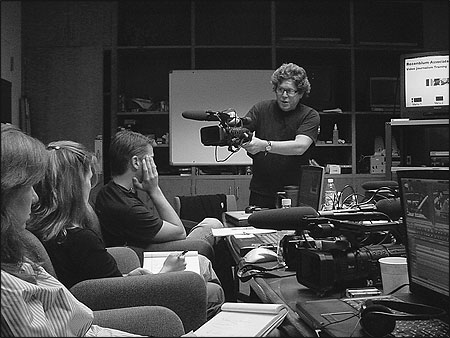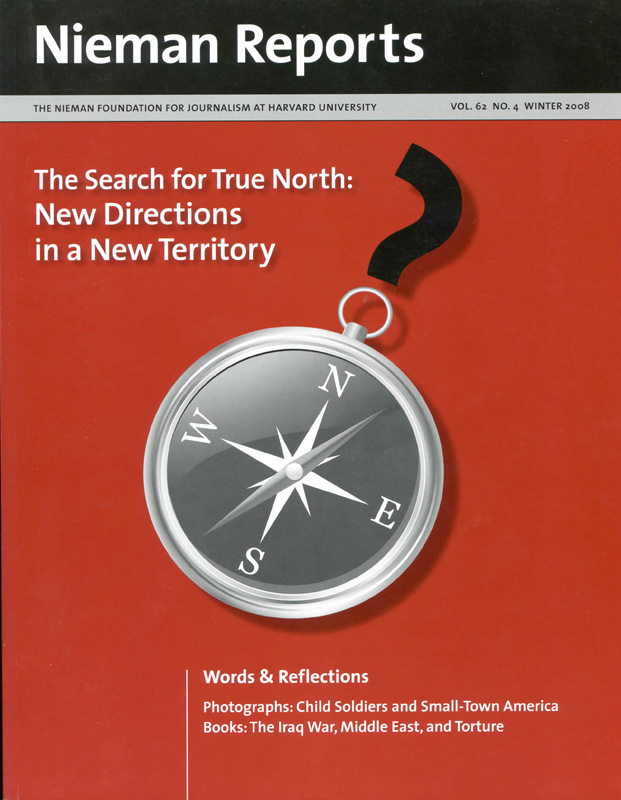
Michael Rosenblum conducts a VJ training session at KRON4 in San Francisco. Photo by Lisa Lambden.
In 1988, I was a producer for “Sunday Morning,” the CBS News show with Charles Kuralt. At the age of 30, it was a pretty good job. I made a good salary, and I got to travel the world. It was a prestigious job and a good start to my career in network television.
So I quit.
I quit because I had grown increasingly frustrated with the way that television journalism was made. Everything was incredibly complicated: cameramen, soundmen, vans, equipment, talent, lighting, audio. The simplest bit of video seemed to take forever to shoot. It was like a Hollywood movie doing a scene: endless preparation and an army of workers to manufacture a few seconds on the screen.
I had first been attracted to visual journalism by photography. I had been mesmerized by the images in Life and in books by Magnum photographers. When I graduated from Williams College in 1976, I received a grant from The Thomas J. Watson Foundation to spend three years traveling around the world photographing. On my own.
I spent the first year traveling from London to Kathmandu, Nepal, overland, camera in hand. I was able to spend months in Afghan villages or in Isfahan in Iran, really getting to know a place. The photographs reflected a certain sense of intimacy. The second year I moved in with a family in a Palestinian refugee camp, and the third year I crossed Africa overland, taking pictures all along the way.
When I went to work in the TV business, it was incredibly different. We might spend a few hours, at the most, shooting a story. When the crew was working, the clock was running. And it was annoying not to have the camera myself. I began to wonder if it was not possible to make television journalism the way I had made photojournalism—alone, living the story, just me with my camera in my hand—spending real time with the subjects.
So in 1988, I quit my very nice job at CBS News and headed back to the Gaza Strip with a small, inexpensive camcorder. I moved in with a Palestinian family in the Jabalya Camp and spent a month shooting and talking to them. When I left, I took my tapes to “The MacNeil/Lehrer NewsHour” and sold them two pieces for $25,000 each.
I had discovered a new way of working in television journalism. Twenty years later, my views have not changed. But the technology has. Today a small, hand-held, high-definition video camera, one that is unquestionably broadcast quality, costs less than $1,000. Audio equipment, radio microphones, and the like have gotten better and smaller. Editing systems, which used to take up an entire room and cost more than a half million dollars, have been reduced to a piece of software that more often than not comes free with your computer.
What does this mean? It means that we have a unique opportunity to reinvent television journalism. No longer does it have to be complex, expensive, difficult, require an army of technicians, or rest in the hands of the very few. It is now possible for a person working on his or her own to make high-quality, intelligent and, most importantly, very inexpensive television. No cameramen. No one carrying the audio equipment. No producers. And no “on-air talent.” This means the barriers to entry have not been lowered—they have been completely blown away.
Technology Accelerates Change
So the question to ask now is, what can we do with the technological revolution at our fingertips?
The first thing is to decouple television news from the TV news people. The idea that we would take the most powerful means of communicating news and ideas ever invented and consciously turn it over to a tiny handful of self-appointed “professionals” is an act of cultural and intellectual suicide. Who are Brian Williams and Katie Couric, after all? Each is just one more (highly paid) journalist with something to say and a platform given to them to say it. Fine. But there are millions (quite literally) of others who also have stories to tell or opinions of equal value to voice.
Never, in the world of print, would we say that all books sold would be written by Katie Couric and Brian Williams. That would be seen as insane. Yet we gladly embrace this ridiculous approach in television news every day. Why does this happen? Up until now alternative voices have been silenced because producing television news was expensive and getting video images into people’s homes was vastly complicated. No more.
So what we are doing now is empowering millions of journalists (and others) to be a part of this great global dialogue we call television and video news. I call it a dialogue, but that is really the wrong term. Monologue might have been more appropriate for the past, so perhaps “multilogue” is a better term to describe its future.
RELATED ARTICLE
“Live Web Cast—From a Newspaper’s Newsroom”
– John HassellDuring the past few years, I’ve been working with journalists at news organizations—not only broadcast outlets—to pass along my enthusiasm for and the techniques that enable this approach to video news to work. Recently, at The Star-Ledger in Newark, New Jersey, 20 print and photojournalists were empowered to create television journalism. Whether their video news stories appear on their Web site, as they do, rather than being broadcast, is immaterial; the reporters use video they shoot and edit themselves to tell news stories.
As it turns out, making TV news isn’t any more complicated than picking up a camera and starting to shoot. Nor is video editing more complex than word processing—and the equipment to do it is no more expensive to purchase. So this puts us at the precipice of a revolution. It’s a revolution in how television news gets made and, as such, a revolution in who gets to make it.
The first recruits to this videojournalist revolution were, of course, those already in the business—the huge armies of journalistic “support staff” who populated TV stations and networks. They were in the office, working for NBC or CBS, because they wanted to report stories or felt they had something they wanted to say. Yet 99.99 percent of those who work in TV newsrooms never get to create their vision—at least until now. They get to make phone calls or coffee or do research or produce (whatever that means). This approach not only wastes talent, but it’s nonsensical as a business practice.
So the first step was—and still is—to empower those in the business, from local TV news producers to writers to former cameramen and technicians to newspaper reporters and photographers and more. We teach them how to use the digital tools, assure them that they can, and then say the words: “Here’s the camera. There is the door. See you at 6:00.” This is how we make television journalism in the digital age.
Empowering Voices Long Silenced
This is, however, only the tip of the iceberg, because there are millions of others who also have something to say and want a place for their voice to be heard.
J.K. Rowling, a 38-year old single mother on welfare, has an idea for a book. Harry … Something. But she is not a published writer. She is an unemployed mom on welfare. But she also has an idea. The barrier to writing is a pencil and a piece of paper. So she sets to work. She has never interned for Diane Sawyer. She has never made coffee for Brian Williams. She has no “experience.” But she produces Harry Potter and is dogged in pursuing a way for Harry’s story to be told.
What Rowling did with a pencil and paper (or cocktail napkins at the start) anyone can now do with a camcorder and a laptop; they can make their vision. Fulfill their dream. Create. Maybe it stinks. Maybe it’s Harry Potter. Only one way to find out: make it.
This incredible revolution in who gets to make it is percolating into journalism as well.
The United States military has been in Iraq for five years. And U.S. news organizations have covered Iraq during those five years by sending in American TV reporters who, for the most part, don’t speak a word of Arabic, don’t know the country’s (or the region’s) history, don’t know the country, but their reports dominate the nightly news. At the same time, there are probably a million Iraqis who have home video cameras and who nightly can and do record the destruction that has been wrought on their nation. In five years, how much of that video have Americans ever seen?
Exactly my point.
Now, this is going to be upsetting to many of my colleagues in the business. When anyone can pick up a video camera, shoot a story and post it on the Web, then the “TV professionals”—an oxymoron, to be sure—are no longer so special.
No, they aren’t. If we profess to believe in a free press, then it doesn’t make sense to get freaked out when a free press actually starts to emerge. A.J. Liebling wrote, “Freedom of the press is guaranteed only to those who own one.” Today, pretty much anyone can own the means to report and produce video news. To which I say, “Good.” It’s going to get very competitive out there, and it’s about time it did.
As we begin by empowering journalists of all stripes, the democratization of video will not be contained within newspaper or TV newsrooms—nor should it. Everything about our time tells me that we are about to embark on a great global awakening. Voices that have never been heard are about to make themselves known, and the rather tiny spectrum of information and opinion that has dominated our national and global public discourse is about to be split wide open. And, I say, high time.
Michael Rosenblum has run Rosenblum Associates for 20 years, training news organizations throughout the world in how to equip and prepare their staff to work as videojournalists. Among his clients have been the BBC, the Voice of America, NY1, The McGraw-Hill Companies, Verizon, TV4 Sweden, and WKRN-TV in Nashville, Tennessee. He also was a founder of New York Times Television and Current TV.


